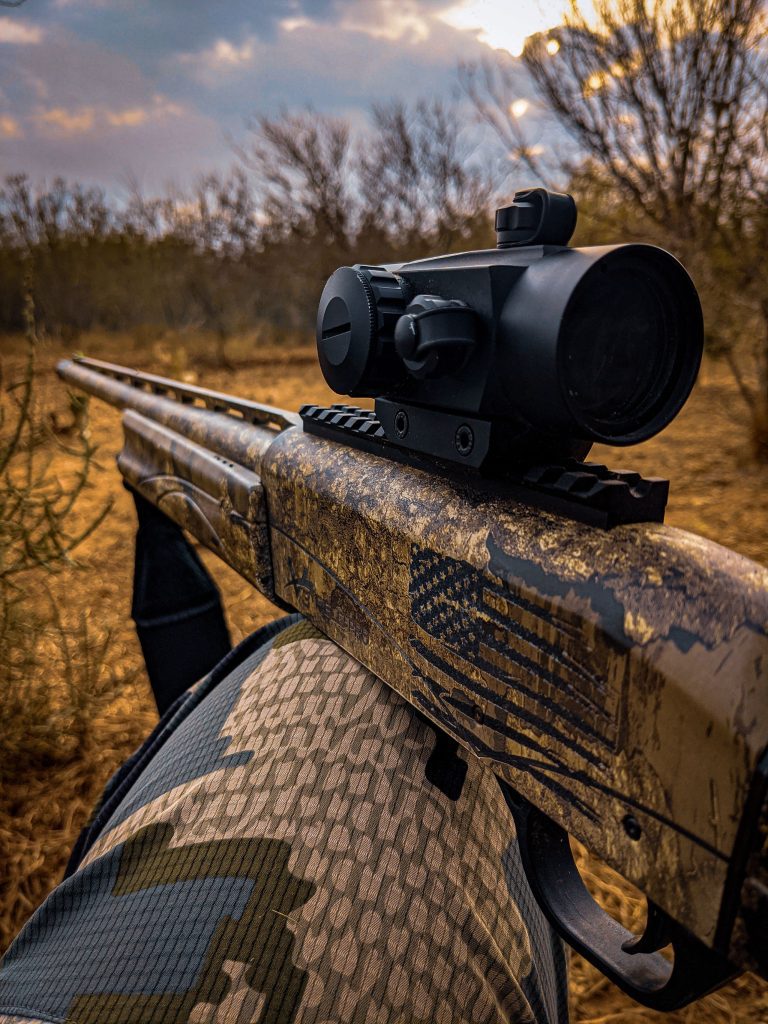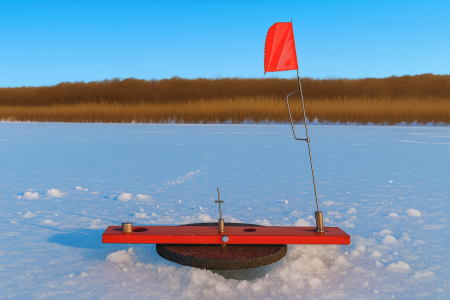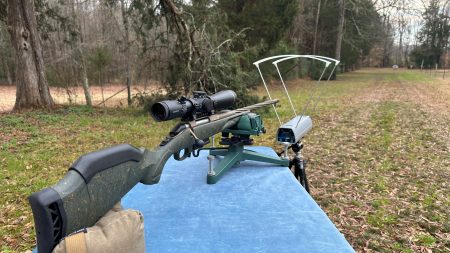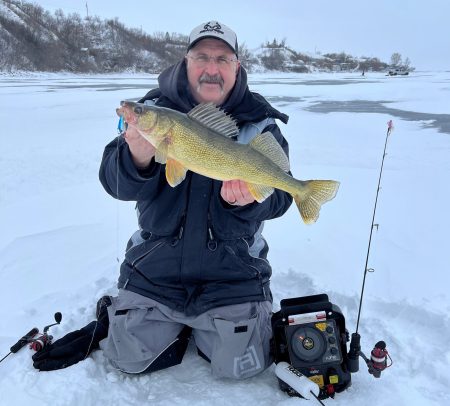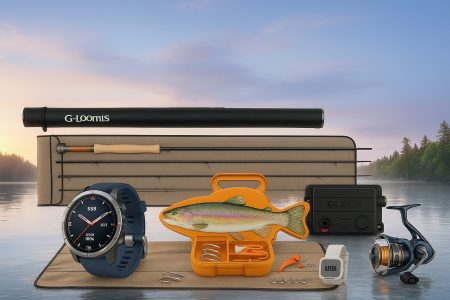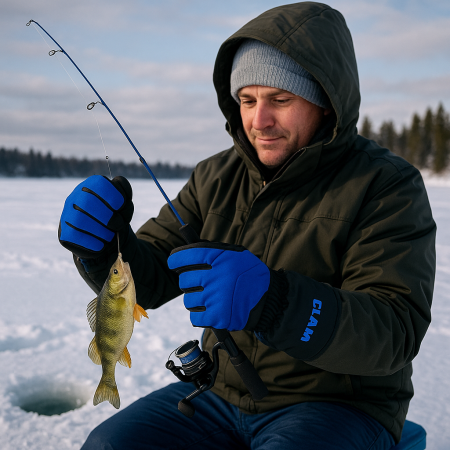There’s no secret that you can kill a longbeard with everything from a .410 to a 10-gauge, crossbow to compound or even a recurve. Heck, turkey hunters of the early days likely ventured out with nothing more than their favorite pump-action shotgun with whatever shells they had laying around on the kitchen table and that worked just fine. But those days are long behind us, with this sector of the hunting world looking drastically different than it once did.
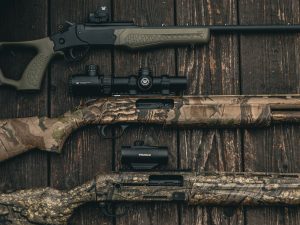
Some time back in the early 2000’s I can recall standing in a gun shop, looking over the few turkey guns that they had and noticed a shotgun that didn’t look like anything else on the same shelf. It wasn’t the camouflage pattern or extended choke that made it stand out, it was the oversized pistol grip that screamed “tactical turkey hunter”. Admittedly, I was intrigued to see this thing in action. Was this what the turkey hunting world had been missing? Would this grip fix all of the flaws in my game? Or was this just the latest “looks cool and has little purpose” accessory that had hit the market? Come to find out, it was just the tip of the iceberg when it came to turkey shotguns getting a complete overhaul. And, around this same time, the fairly subdued world of turkey hunting began to shift toward a much more tactical one. With ammunition manufacturers refining load calculations to meet the demand of the modern-day turkey hunter, firearm companies were doing the same in their own ways. I remember holding that pistol grip and saying, “what will they do to these things next, a scope?”. Little did I know that very thing would soon flip the entire turkey scene on its head.
Fast forward into today’s world and turkey guns are looking less like your grandfather’s favorite wooden stock turkey killing pump gun with each passing minute. Whether it’s because of the grip, the super compact barrel lengths or whatever one of the numerous other accessories mounted on it, turkey shotguns have turned the corner from being just another shotgun to becoming a precision hunting weapon. And much like precision centerfire rifles, optics are now playing a major role in the next generation of gobbler guns.
Selecting a Scope – Red Dot or Variable Zoom?

When turkey hunting optics first came onto the scene, the majority of them were low power 1-4x scopes. These optics were great at allowing the hunter to get on target quickly, but to also have the ability to zoom ever so slightly if they wanted to. And, boy did that make a world of difference when you compared that to your shotgun with a front bead sight. Though after a few seasons, the added weight of these sights could get cumbersome, especially if you were trekking up and down ridges in search of birds. Eventually, the low powered scopes were generally phased out by much smaller and lighter red-dots, which is what most shotguns are suited up with today. However, these scopes shouldn’t be forgotten about, particularly with some TSS loads achieving extremely tight patterns beyond 60 yards. Additionally, several options are designed with illuminated reticles for low light conditions. And, as the expression goes “what’s old is new again”, lightweight, variable zoom scopes, like the Vortex Crossfire II, are starting to emerge onto the turkey scene to allow for extended range precision. Equipped with an illuminated reticle and 4x zoom and weighing less than 15 ounces, this scope is perfect for a long-range turkey setup.
The Alignment Factor.
During the early days of turkey hunting optics, the reason to mount a scope was more or less because of the comfort of aiming. And, as every turkey hunter knows, those random misses with an open sight leave even the most seasoned hunters scratching their heads in disbelief. “How did I miss? I had the bead right on his head!”. I’ve been there more times than I can care to remember, and it all comes down to how I was positioned on the gun. Unfortunately, open sights require you to be aligned perfectly to correctly aim and I think that this is what accounts for common misses. Now don’t get me wrong, you can still successfully kill a turkey without the perfect cheek weld on your gun, but your odds of hitting exactly where you aim aren’t perfect.
Red dots and other holographic weapon sights allow your gun to hit whenever the reticle is positioned over the target. Now, I know that sounds elementary, but hear me out. As long as you can see the reticle over your target, that is where your shotgun is aiming. This is significantly different to an open bead sight, which requires you to be aligned perfectly to aim. This one factor has been enough to keep an optic on my shotgun for the last number of seasons without any issues.
Joining the New Ammo Generation
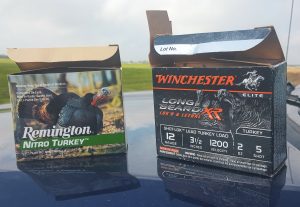
Maybe it’s just me, but I think that today’s turkey ammunition can be separated into three grades. Grade one is what most of us got started turkey hunting with. A standard box of #6’s that does its job in virtually any shotgun. With strutting gobblers inside of the 25 yard zone, these shells are fantastic, especially with a shotgun with an open sight. Grade two is more of a hybrid version that holds together at greater distances, giving you the ability to kill birds at 40 yards comfortably. Finally, grade three; the world of TSS loads and its siblings that can lay birds out cold at virtually any range under 60 yards, but not without a steep price tag. I think that once you make the jump from grade one into grade two ammo, installing a scope on your turkey gun becomes critical. And, not just critical because of how nice it is to put a red dot or crosshairs on a gobbler’s redhead, but more so because of the fine-tuning factor when sighting in. Grade two and especially grade three ammunition really benefits from being tuned to your specific shotgun. When paired with the right choke tube, these two higher end types of turkey loads can really tune well on paper and it’s worth every minute to find the right combination of choke and ammo.
Adjustable brightness.
I never hated the fiber optic sights that I had on any of my turkey guns, especially when those were the biggest upgrade that could be made to your shotgun. Though, there were many gray, gloomy mornings that I wished I had more brightness on the front of my barrel. It certainly can sound a bit trivial, but not having a bright, glowing sight is tough. To me, having the ability to fully adjust the brightness of the reticle on my optic is a huge blessing on days where the sun is either not enough or sometimes too much.
Faster target acquisition.
Undoubtedly, one of the most critical pieces to knocking down the gobbler that you’re after is getting on target quickly. If you’re set up in a comfortable position and have a great vantage point to watch that gobbler, come into your decoys, while being down on your gun, then your chances of bagging that bird increase dramatically. But, as we all know, things don’t always work out as planned and sometimes you’re left with your gun in your lap, forcing you to make a quick move to shoot. In these scenarios, I think that it’s much easier to mount your shotgun, find your red dot and squeeze the trigger vs. getting a proper cheek weld and aligning to your fixed sights. With many red dot type optics sitting a bit higher on the receiver, they ultimately allow for a more forgiving and quicker time to get “on the gun”. For example, the PR1 from TruGlo is red dot sight that’s designed to sit higher on your shotgun, allowing for faster, more accurate shooting.
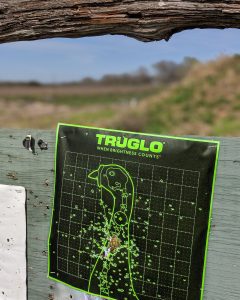
In my opinion, if you’re looking to build the ultimate modern-day turkey killing shotgun, then it’s not a question of “if” you should mount an optic, it’s a question of what type. When you combine the factors of having a super tight choke tube and premium heavy-weight ammunition, your successful striking range improves radically. And though some hunters would argue that they like to kill their strutters up close and personal, it’s hard to argue against having a shotgun that throws grapefruit size patterns at 50+ yards, just in case you need it. If anything, it’s worth shooting a gun with and without a scope side by side to see what works best for you. At the end of the day, choose whatever you mount, align with and shoot the best. But for the time being, I’m sold on keeping an optic on my rig!
You may also like: Tips and Tactics for Spring Turkey Season Preparation
Per our affiliate disclosure, we may earn revenue from the products available on this page. To learn more about how we test gear, click here.






